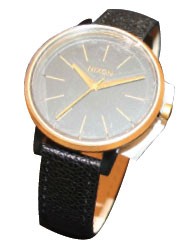Meet the Experts watchout
Watch out!
One of our chemical experts sheds some light on how new EU regulations will affect the watch market, and how AnchorCert Analytical carries out its testing.
The enforcement date for the REACH (Restriction, Evaluation and Authorisation of Chemicals) Regulation for lead on 9th October is the latest landmark date for our industry in the European legislative calendar. Fashion and fine jewellery, watches and fashion accessories are now subject to a growing assortment of regulation.
Watches have always been amongst the most regulated of these products, with various functional specifications and criteria that must be met if product descriptions such as ‘waterproof’ are to be used. However, in recent years this has been matched by burgeoning general product safety legislation. Mintel estimates suggest that nearly nine million UK adults bought a watch in 2012 and with this volume of consumers potentially at risk if product safety requirements are not met, retailers are becoming increasingly rigorous with the requirements they impose on their suppliers.

Many parts of a watch are clearly intended to come into “prolonged and direct contact with the skin” meaning these components must comply with the nickel regulation. This legislation has been in place since 2000, so most suppliers are delivering compliant product on a regular basis. However, recent changes to the prescribed method, EN1811:2011, have significantly reduced the amount of nickel release which is permitted and some components, particularly watch crowns are failing.
These same components now also need to comply with the restrictions on lead and cadmium content, which specifically mention wristwatches. For lead and cadmium each individual material must fall beneath the threshold which is 0.01 per cent by weight (100mg/kg) for cadmium and 0.05 per cent (500mg/ kg) for lead. So far, so good and no surprises for anyone who has worked in metal industries and understands the damage to industrial workers historically caused by cadmium fumes and the impact that the slow release of lead into the body can have on development and behaviour.
How we Assess
As with every process carried out at Assay Office Birmingham, the samples are first subjected to an expert visual assessment. For leather straps the team will verify whether the material is actually leather, as defined by BS 2780:1983, or whether it is a textile material. This is done by examining a cross section of sample under the microscope.
Leather samples then need to be ground down in a macerator to carry out the chemical tests. Leather fibres are very tightly interwoven and have to be reduced to a fibrous powder so that the chemicals can be reliably extracted by dissolving them into a solution. This requires the addition of water or buffer solution initially and a defined period of shaking to assist the extraction of the chemicals.
However, the regulation does not stop there and literally every fibre of a watch strap could be subject to some restriction to ensure it does not pose any health and safety dangers to the future owner. Whether they are leather, fabric or plastic most watch straps will undergo some product safety or quality testing. The cadmium and lead regulation applies to metal, plastics and paints/coatings and all parts must be compliant. As well as checking for harmful chemicals, suppliers will also carry out tests from a customer satisfaction aspect, checking colour fastness to ensure that dye will not rub off onto either clothing or skin during prolonged wear.
 AnchorCert Analytical offers all the tests required for a watch, including those associated with the non-metal parts. There are clearly defined content limits for chemicals which are recognised to be dangerous: formaldehyde, azo dyes, DMF and PCP’s” says Ben. Chromium VI is also widely recognised as a danger. It is already restricted by national legislation in Germany and the consultation is in progress prior to it being included in the EU REACH Directive in the near future. Physical tests may also be required to check the impact of continuous wear, by subjecting the sample to wet and dry rubbing and perspiration.
AnchorCert Analytical offers all the tests required for a watch, including those associated with the non-metal parts. There are clearly defined content limits for chemicals which are recognised to be dangerous: formaldehyde, azo dyes, DMF and PCP’s” says Ben. Chromium VI is also widely recognised as a danger. It is already restricted by national legislation in Germany and the consultation is in progress prior to it being included in the EU REACH Directive in the near future. Physical tests may also be required to check the impact of continuous wear, by subjecting the sample to wet and dry rubbing and perspiration.
In addition to these existing restrictions which relate to the safety of a watch during its useable life, most watches are also captured by the new Restriction of Hazardous Substances (RoHS 2) legislation which seeks to reduce the amount of hazardous material being used in electronic products.
RohS restricts the use of specific elements and compounds in electrical equipment, and watches and clocks fall into this group of products along with all components sold as part of an electronic item. RoHS restricts mercury, Lead , chromium VI, flame retardants polybrominated biphenyl (PBB), and polybrominated biphenyl ether (PBDE) to 0.1 per cent by weight and cadmium to 0.01 per cent by weight. There is an anomaly here with the lead levels of 0.05 per cent allowed by REACH and suppliers need to keep abreast of all this legislation to ensure they do not fall foul of the new regulations included in both the REACH and RohS regulation.
Your item has been added to the basket
You need to create an account, or login before you can add this item to your basket.

